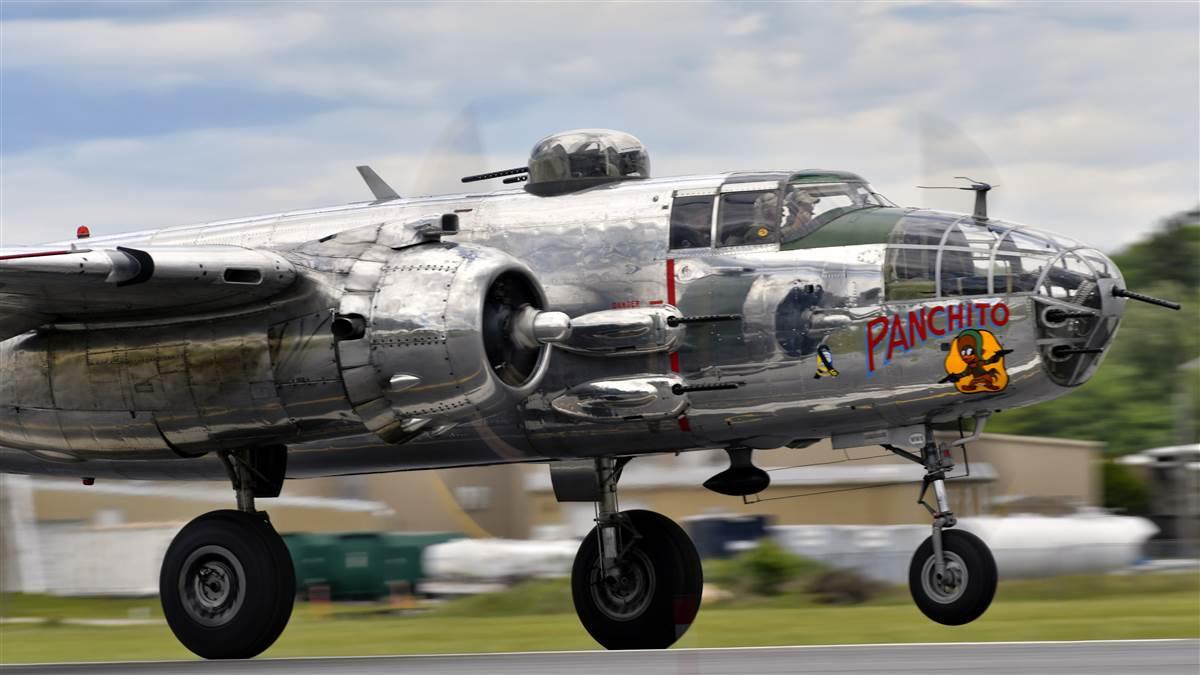Milestones: He nailed it
U.S. Air Force vet returns to B–25 after six decades

With the nimbleness more akin to a 24-year-old than an 84-year-old, Sid Ellner maneuvered his way from the B–25 jumpseat to the left seat, taking the controls of the lumbering bomber for the first time in 61 years. As instructed, he pushed the nose over right after takeoff, allowing the speed to build to 145 mph, deemed the safe single-engine speed, before pitching back up to a climb. Meanwhile, co-pilot Calvin Peacock deftly nudged the throttles, prop controls, and mixture to set up for a cruise climb. Ellner leveled off precisely on the assigned altitude and started a few turns, his mind rewinding to the mid-1950s when he trained in the B–25, preparing for his role as a B–36 pilot in the Strategic Air Command. A few minutes later, the long runway at Delaware Coastal Airport came into view, the windsock pointing accusingly across the pavement. Keeping the crosswind in mind, Ellner lined up Panchito for a long final, bringing it in for a steep approach, as he remembered doing during his U.S. Air Force days. With some coaching from Peacock, he rounded out and set the aging bomber down, a look of satisfaction on his face.
“You made an old man very happy today,” Ellner said with a smile after his orientation flight in Panchito, an airplane the veteran likely flew when he was undergoing multiengine training at Vance Air Force Base in Enid, Oklahoma, in the 1950s. Peacock, an expert on the B–25J’s history, said the airplane was based there at that time.
Ellner reunited with the bomber at its home base at Delaware Coastal Airport in Georgetown, Delaware, having flown his Cessna 172RG from White Plains, New York, where he is based. “Sitting there toward the end, I started to feel comfortable. A lot of it came back to me,” he said.
Ellner read about the Delaware Aviation Museum Foundation’s program offering flight training in Panchito in the form of type ratings, second-in-command type ratings, and orientation flights. He called Peacock, who is the director of training, and set the wheels in motion, wanting one more chance to fly his favorite airplane.
“Of all the airplanes that I’ve flown that was really the best,” he said, gesturing to the gleaming twin-engine bomber. “My favorite airplane. I have great memories.”
In ROTC while in college at the University of Connecticut, Ellner chose the Air Force in 1955, entering the service as part of Class 55-Q. “We were the very first class to go through as officers,” Ellner said. Previously, cadets went through flight training. Officers didn’t always adjust well to the flight training regimen, he said, noting it took the air force a couple of years to figure out how to handle officers as pilots in training.
Ellner’s training started in a Piper J–3 Cub at Bartow Air Base in Bartow, Florida, and he then quickly graduated to the T–6, with its 600-horsepower engine. “We thought that was the cat’s pajamas,” he said. His bomber track led him to the B–25 and ultimately to the B–36, where on a few occasions he flew live nuclear weapons. One mission had them flying nonstop from Spokane, Washington, to Guam, 35 hours without refueling. “That gives you a sense of the range of that airplane,” he said.
He left the military in 1957, but he didn’t leave flying or his friendships behind. “I think more of my friends and fellow classmates who aren’t here anymore. There’s something about flying relationships that you end up with friends for a lifetime. It’s a very unusual kind of relationship.”
Spry, sharp, and always ready with a funny quip, joke, or punch line, Ellner impressed Peacock, who has flown many veterans in Panchito. “Sid is a rather remarkable individual. Very, very sharp,” said Peacock. “He nailed” the flight. “There are not many military-trained B–25 pilots left who are still active pilots.”
Email [email protected]




